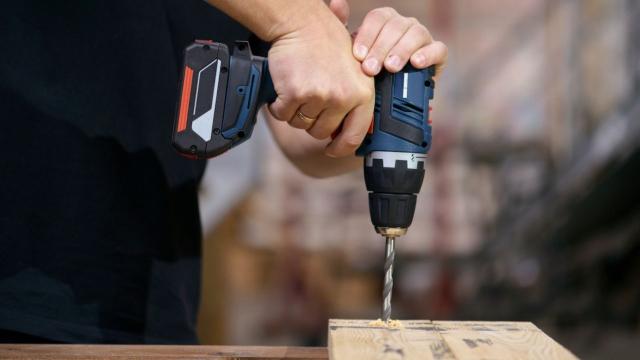If you’re considering a new tool purchase, or just trying to choose the right tool for your project, all the different options can seem confusing. Drills, impact drivers, and hammer drills have a lot in common, and they even have some overlapping features, but there are some key differences. Here’s a guide to these tools and their features to help you tackle your DIY venture with confidence.
Why are these tools similar?
These tools will all drive a screw with the right bit in them. They’re all designed to hold a bit and rotate for drilling into material like lumber and they will all drive hardware (e.g., a screw). Because of this, you might think of them as being interchangeable, but the amount of power they can exert is quite different.
Drills
A cordless drill is intended to primarily be used to drill holes into materials such as lumber or similar materials. What makes a drill different from an impact driver and a hammer drill is that it doesn’t include an impact as a part of its mechanical function. This reduces the amount of power that the drill exerts and makes it a gentler option. A traditional drill can be used for driving screws and sometimes even nuts, although it won’t provide as much assistance to the user when it comes to additional torque. A drill is best suited for drilling into more delicate materials and driving screws with a controlled amount of torque to prevent splitting. The other benefit of a regular cordless drill as opposed to an impact driver or a hammer drill: It’s much quieter.
Impact drivers
An impact driver is designed to assist the user with driving longer or wider hardware using extra torque. This is caused by the striking force of an internal hammer and anvil controlled by a spring that adds extra force at regular intervals to drive the rotating shaft faster, thus giving the driver more force. Impact drivers will also turn a drill bit, although they require an adapter or a quarter-inch hex shank attachment for a bit to be compatible with them. If you’re working with longer or wider hardware, or working with tougher material that you’re trying to drill through, an impact driver will work well.
Hammer drills
A hammer drill is like a traditional drill crossed with an impact driver and it’s larger and more powerful than a regular driver. A hammer drill has a larger, half-inch chuck, and looks and functions similarly to a regular drill except that it has spring-driven hammer and anvil component, much like an impact driver. These drills are generally used for drilling through more challenging materials like concrete or stone. It’s usually a good idea for safety’s sake to use the extra control handle that often comes with this type of drill, as the amount of force it can exert can be stronger than your bare hands.
Choosing the right tool for the job
The more force a drill can exert, the higher the risk of causing splitting or snapping of hardware, so it’s a good idea to use proportional force to the project you’re working on. Driving hardware or a drill bit too fast can cause it to snap. Excessive force can also cause heat to damage the bit or the hardware. For more delicate, wood projects, a regular drill works well. For slightly larger projects, or for driving larger hardware, an impact driver is a good fit. For masonry or extra large bolts, using a hammer drill will do the job.
Lead Image: Shutterstock

Leave a Reply
You must be logged in to post a comment.